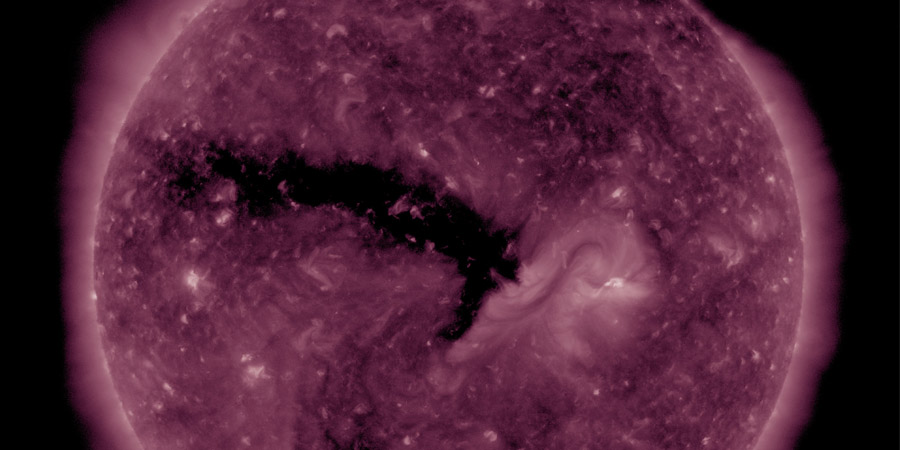Coronal hole faces Earth
Friday, 6 April 2018 19:07 UTC

A familiar coronal hole has returned! It is a thin east-west aligned northern hemisphere coronal hole close to the solar equator that is facing our planet today.
This coronal hole was the cause for a lot of drama last rotation with lots of fake news items floating around on the internet about it causing massive geomagnetic storming and other dramatic events which turned out to be a pile of nonsense.
However, this coronal hole did cause some geomagnetic storming during the last rotation and sparked some vivid auroral displays. In fact, we briefly even reached up to the moderate G2 geomagnetic storm level but only during one 3-hour period on 18 March as the high solar wind speed and prolonged southward pointing IMF (Bz) possibly aided by the equinox effect stirred up enough for geomagnetic activity for moderate storm conditions.
Are we going to see similar effects this time around? That is hard to say but the coronal hole didn't change its shape all that much since it faced us last time so its pretty likely we will at least reach the minor G1 geomagnetic storm level again this time around.
The solar wind stream will likely arrive at Earth on 9 April and due to the elongated shape of this coronal hole, the stream will likely persist for multiple days. For high latitude sky watchers in the northern hemisphere this might be your last opportunity for some nice auroral displays until the midnight sun takes over! Good luck!
A transequatorial coronal hole is facing Earth. Enhanced solar wind could arrive in ~3 days. Follow live on https://t.co/bsXLidnzGh pic.twitter.com/DIeAK3K2hJ
— SpaceWeatherLive (@_SpaceWeather_) April 6, 2018
Thank you for reading this article! Did you have any trouble with the technical terms used in this article? Our help section is the place to be where you can find in-depth articles, a FAQ and a list with common abbreviations. Still puzzled? Just post on our forum where we will help you the best we can!
Latest news
Latest forum messages
More topicsSupport SpaceWeatherLive.com!
A lot of people come to SpaceWeatherLive to follow the Sun's activity or if there is aurora to be seen, but with more traffic comes higher server costs. Consider a donation if you enjoy SpaceWeatherLive so we can keep the website online!

Space weather facts
| Last X-flare | 2025/03/28 | X1.1 |
| Last M-flare | 2025/04/01 | M2.4 |
| Last geomagnetic storm | 2025/03/27 | Kp5 (G1) |
| Spotless days | |
|---|---|
| Last spotless day | 2022/06/08 |
| Monthly mean Sunspot Number | |
|---|---|
| February 2025 | 154.6 +17.6 |
| April 2025 | 147 -7.6 |
| Last 30 days | 128.8 -21.8 |


